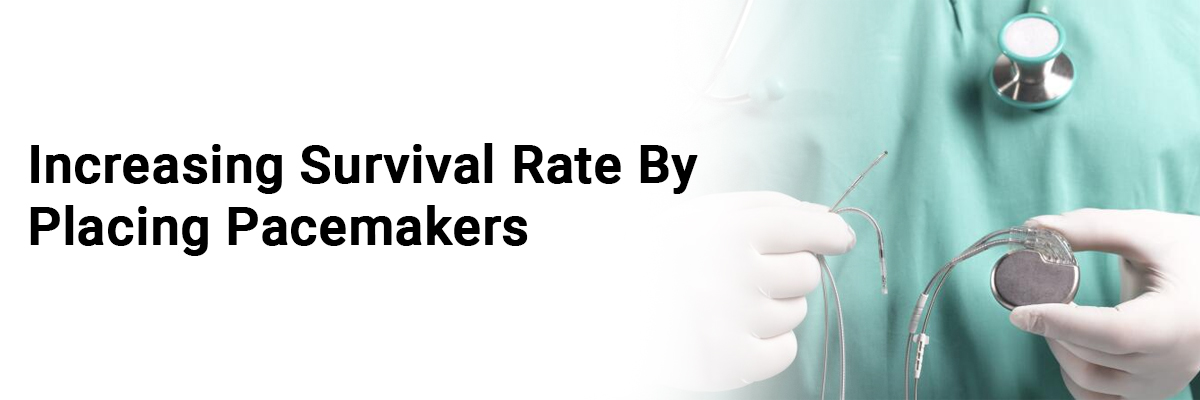
 Mrs. Mayuri Mathur
Mrs. Mayuri Mathur
Increasing Survival Rate By Placing Pacemakers
Heart
disease is the leading cause of death worldwide, affecting people of all ages.
One of the most common treatments for heart disease is the placement of a
pacemaker, a small device that helps regulate the heart's rhythm. Pacemaker
placement has been shown to improve survival rates in patients with certain
types of heart disease.
This
article will explore the science behind pacemaker placement and its role in
increasing survival rates.
What is a Pacemaker?
Pacemakers
are typically used to treat heart conditions, heart-rate fluctuations, and
heart electrical system problems. They are small electronic devices surgically
implanted into the chest and connected to the heart, providing electrical
stimulation to regulate the heart rate when necessary.
The
pacemaker is assembled with a generator, a wire lead, and a sensing system. The
generator is a small device that contains a battery and a computer chip. The
generator is implanted in the body and is responsible for creating and sending
electrical signals to the heart. The wire lead is a thin wire that connects the
generator to the heart muscle. The sensing system is a set of electrodes that
monitor the heart rate and detect any problems.
How Does a Pacemaker Work?
A
pacemaker detects when the heart rate is too slow or too fast and sends
electrical signals to the heart muscle to make it contract and pump blood. The
electrical impulse is generated by a small generator within the pacemaker and
is sent to the heart through one or more wires called leads. These leads are
placed in the heart and help to stimulate the heart's contractions.
When
the pacemaker is turned on, it continuously monitors the heart rate and sends
electrical signals to the heart muscle to keep it beating at the right speed.
The pacemaker also has the ability to detect any changes in the heart rate,
make adjustments as needed and help the heartbeat at the correct pace. This
process is called pacing.
Who is a Candidate for Pacemaker Placement?
Pacemaker
placement is typically recommended for patients with certain types of heart
disease, including bradycardia and heart block.
Additionally, doctors may recommend pacemaker placement for patients with other
types of heart disease, such as heart failure, or those who have had a heart attack.
Other
conditions that may require pacemaker placement include:
●
Atrial fibrillation
●
Atrioventricular block
●
Sick sinus syndrome
●
Syncope
Patients
with symptoms such as fatigue, shortness of breath, and chest pain may be
candidates for pacemaker placement. A thorough evaluation by a cardiologist is
necessary to determine if pacemaker placement is the right treatment option for
a patient.
How Does Pacemaker Placement Increase Survival
Rates?
Pacemaker
placement can increase survival rates in several ways.
1.
First, by regulating the heart's rhythm, pacemakers can help to improve the
heart's efficiency, leading to improved blood flow and
oxygenation to the body's tissues.
1.
Additionally, pacemakers can help to reduce the risk of serious
complications, such as heart failure, stroke, and sudden
cardiac arrest.
1.
Pacemaker placement can also improve the quality of life for patients with
heart disease. It can relieve fatigue, shortness of breath, and chest pain and
help patients return to normal activities.
The Procedure of Pacemaker Placement
Pacemaker
placement is a relatively simple and safe procedure. The procedure is typically
performed under local anesthesia and takes about an hour to complete.
Before
the procedure, the patient will have a thorough evaluation by a
cardiologist to determine if pacemaker placement is the appropriate treatment
option. This will include a physical examination, an electrocardiogram (ECG),
and other tests such as an echocardiogram or a chest x-ray.
The
patient will also be instructed to stop taking certain medications and fast for
a certain period before the procedure. They will also be given instructions on
preparing for the procedure, including what to wear and how to care for the
incision site after the process.
During
the procedure, the pacemaker and leads are inserted through a
small incision in the chest or abdomen and then connected to the heart.
After
the procedure, the patient will be monitored in the recovery room
for some time. They may experience discomfort and swelling at the incision
site, but this can be managed with over-the-counter pain medication.
The
patient must follow up with their doctor for regular check-ups to ensure the
pacemaker is working correctly. The doctor will also perform regular tests to
ensure the pacemaker is functioning correctly and that the patient's heart
rhythm is stable.
What are the risks and side effects of pacemaker
placement?
As
with any medical procedure, there are some risks associated with pacemaker
placement. These include infection, bleeding, and allergic reactions to the
anesthesia. In rare cases, the pacemaker or leads may need to be removed or
replaced. However, the risks associated with pacemaker placement are generally
low and most patients experience little to no complications.
It
is important to note that pacemaker batteries have a limited lifespan and will
need to be replaced once the battery is depleted.
The Bottom Line
In conclusion,
Pacemaker placement is a safe and effective treatment option for patients with
certain types of heart disease. It helps regulate the heart's rhythm, improve
efficiency, and increase survival rates. Pacemaker placement can also enhance
the quality of life for patients with heart disease. The procedure is simple
and straightforward, with low risk and side effects. Patients need a thorough
evaluation by a cardiologist to determine if pacemaker placement is the right
treatment option for them and to follow up with regular check-ups to ensure its
effective functioning.

Mrs. Mayuri Mathur
Mrs. Mayuri Mathur is a Senior Medical Writer (Patient education and digital) and seasoned content creator with a rich tapestry of expertise spanning over ten years. With a diverse background in content creation, she brings a wealth of experience to the table, from crafting insightful medical articles to developing comprehensive patient education materials, dynamic press releases, and captivating brochures and website content. Throughout her illustrious career, she has demonstrated an exceptional knack for distilling complex medical concepts into easily understandable content, making her a trusted resource for both professionals and lay audiences alike. Her meticulous attention to detail and innate creativity have enabled her to deliver content that not only informs but also engages and inspires. Whether elucidating intricate medical procedures or crafting compelling marketing materials, her versatility and dedication shine through in every project she undertakes. Her passion for writing, coupled with her profound understanding, makes her an invaluable asset to any team or project. In a constantly evolving digital landscape, where effective communication is paramount, Mrs. Mayuri Mathur stands out as a beacon of excellence, consistently delivering top-notch content that resonates with audiences across diverse platforms.

.png)

.png)
.png)




Please login to comment on this article